You can’t be an aquarist for long without eventually falling in love with tropical fish. In fact, it’s fair to say that many fish-keepers’ favorites come from tropical environments. But how about betta fish? Are they also tropical?
I get this query a lot from my newer comrades in fish-keeping, who are eager to understand the environments in which their bettas flourish best.

Right off the bat, I’ll tell you straight: betta fish are tropical fish. What does this connote, though? What are tropical environments, and how can you identify a tropical fish? Also, knowing that bettas come from this environment, how do you curate your betta’s aquarium?
I’m going to answer these questions and more, so come with me and let’s talk about tropical fish.
Contents
What Are Tropical Fish?
Tropical fish are species that live in aquatic tropical environments found along the middle belt of the globe. This general area includes the South American, Caribbean, Mexican, Central American, Northern and Central South American, South and Southeast Asian, and Oceanian regions.
Since these parts of the globe face the sun most directly, their deep water surfaces and shallow waters are warmer than in regions closer to the poles. Tropical fish are thus mostly warm-water animals, although some can survive in much colder waters.
One cool fact about tropical environments is that their shallow water regions are the most conducive to coral reefs and all their vibrant beauty.
Check out these other related posts:
Tropical Fish Characteristics

Tropical regions have the most diverse and unique species anywhere, thanks mainly to getting the most sunlight and having fewer seasonal variations.
The fish in those regions reflect this diversity beautifully. Against the backdrop of vibrantly colored coral reefs, you will find loads of just as brightly colored, exotic species swimming about and exhibiting diverse and exciting behaviors.
These enchanting colors and color patterns, which may vary even within the species, are the most iconic traits of tropical fish. Speaking of exciting behaviors, some tropical fish species can communicate by moaning, grunting, croaking, or drumming.
While these fish have no vocal cords, they can still use other body parts to make these sounds. For example, drummer fish have sonic muscles near their swim bladder—the fastest contracting ones among vertebrates.
The fish can rapidly contract and expand their swim bladders using these muscles to create drumming sounds. Tropical fish also have an excellent sense of taste.
For example, catfish have over 27,000 taste buds—20,000 more than humans. Now that we know about tropical fish and their environment let’s turn to the species you want to know about.
Betta Fish Basics
I’ve said that betta fish live in tropical aquatic environments. However, those environments exist in many regions, and the exact nature of the habitats varies.
For instance, not all tropical waters have saltwater or reefs. I’ve also mentioned that tropical fish have incredibly diverse traits. So, let’s talk specifically about betta fish, their main characteristics, and their natural habitat.
Species Overview
Bettas are a genus of small, ray-finned, and often brightly colored fish. However, we use “betta” to refer to the species nicknamed the Siamese fighting fish and known botanically as Betta splendens.
Bettas (splendens, remember) are very brightly colored fish with elegant finnage and streamlined bodies covered in overlapping scales. Members of the species are relatively small, typically growing no more than 3 inches in length, but they have a few attractive anatomical traits.
The most interesting of these traits (in my view) is the labyrinth organ, which enables bettas to breathe atmospheric air. Consequently, they can survive in a range of shallow water environments most other fish can’t.
Another curious anatomical betta trait is “the beard.” Every betta has a distinct membrane under its gill plate cover; this membrane sticks out like a beard when the betta flares its gill plates, hence the name “the beard.”
Scientific Name: Betta splendens
Common Name: Siamese Fighting Fish
Distribution: Thailand, Cambodia, Vietnam, Laos, Myanmar
Lifespan: Approximately 3 to 5 years
Size: Up to 3 inches (7.6 cm)
Natural Habitat
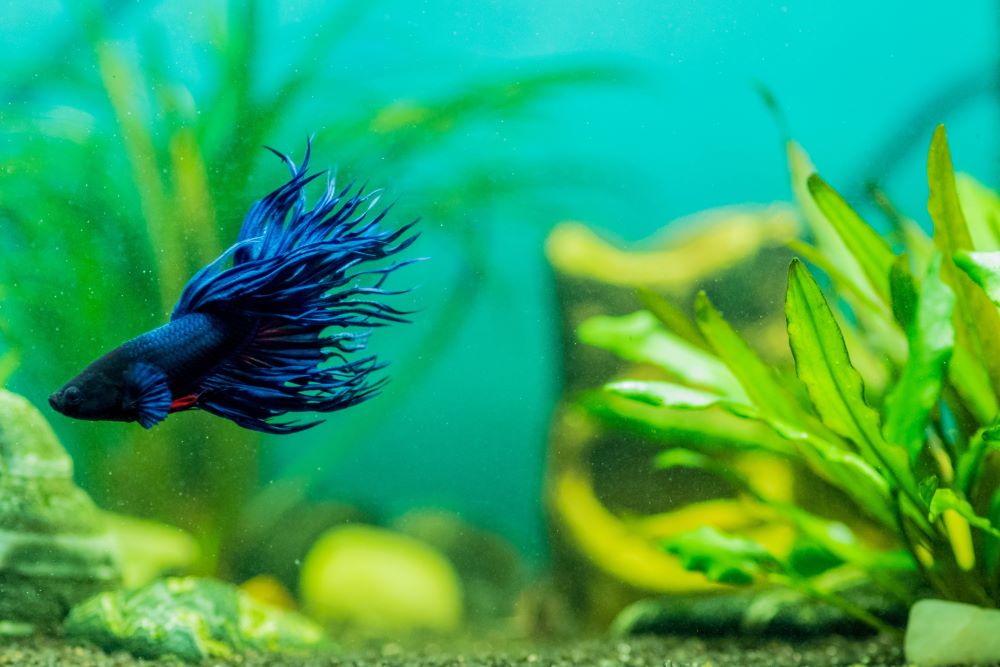
Bettas are freshwater fish like the rest of the genus and are native to Southeast Asia. They live in rice paddies and shallow, slow-moving streams in Cambodia, Laos, Myanmar, Vietnam, Thailand, and the Malay Peninsula. Interestingly, thanks to the history of rice farming in the region, people discovered and domesticated bettas.
The shallow waters in which bettas live are warm and oxygen-poor, and the water and climate conditions may occasionally vary wildly. Still, bettas have adapted well to these conditions, and since the species can survive in harsher conditions than most other fish, they have few natural predators.
Primary Habitats: Rice Paddies, Floodplains
Region: Southeast Asia
Water Temperature: Warm, typically around 78-80 degrees Fahrenheit
Water Conditions: Still, oxygen-deficient environments
Varieties and Aesthetics
Unsurprisingly for a tropical species, Betta splendens is highly variable. Human selective breeding efforts and the species’ natural variability have produced myriad types of bettas in color patterns, as well as body features like tail length and finnage.
Color Patterns
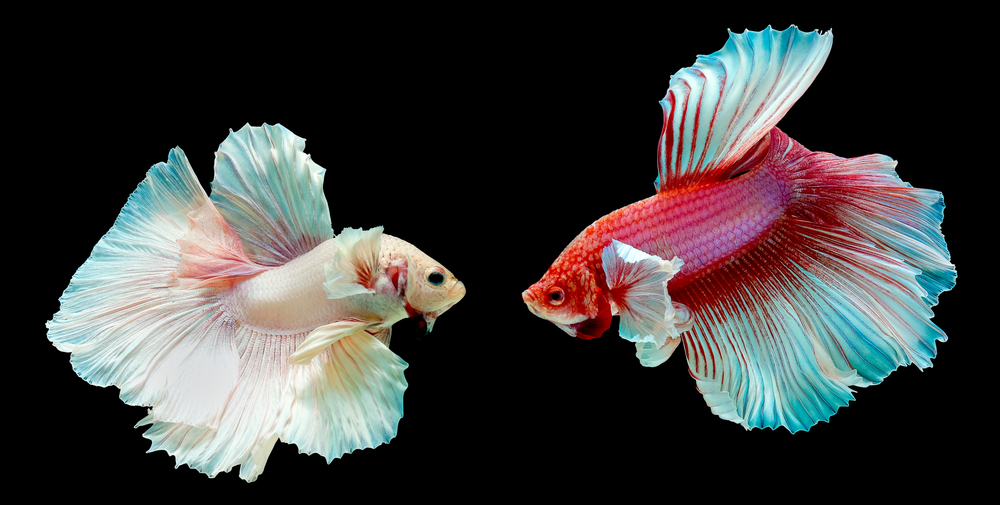
Bettas display a breathtaking array of colors and patterns, including red, blue, green, yellow, purple, and white. These colors can appear as solid hues or in striking combinations, leading to bi-color or koi patterns. These two color patterns are particularly notable in red bettas, which often blend red with other colors or showcase red prominently due to their genetic dominance.
Betta Varieties
You can categorize Betta splendens according to their tail configuration and overall appearance. One common variety is the Veiltail, with its long-flowing fins.
Another is the majestic Halfmoon betta, characterized by a tail that fans out 180 degrees, akin to a semicircular veil. In contrast to these, Plakat bettas boast a more traditional look with their shorter fins that hark back to their origins.
Although types like the Veiltail and Halfmoon are more common, other exotic and rare Siamese fighting fish breeds also captivate collectors and hobbyists alike.
These types include some straight-up designer breeds, such as the King betta, which some claim resulted from breeding Betta splendens with Betta raja, a species endemic to Sumatra.
Aquarium Care and Requirements
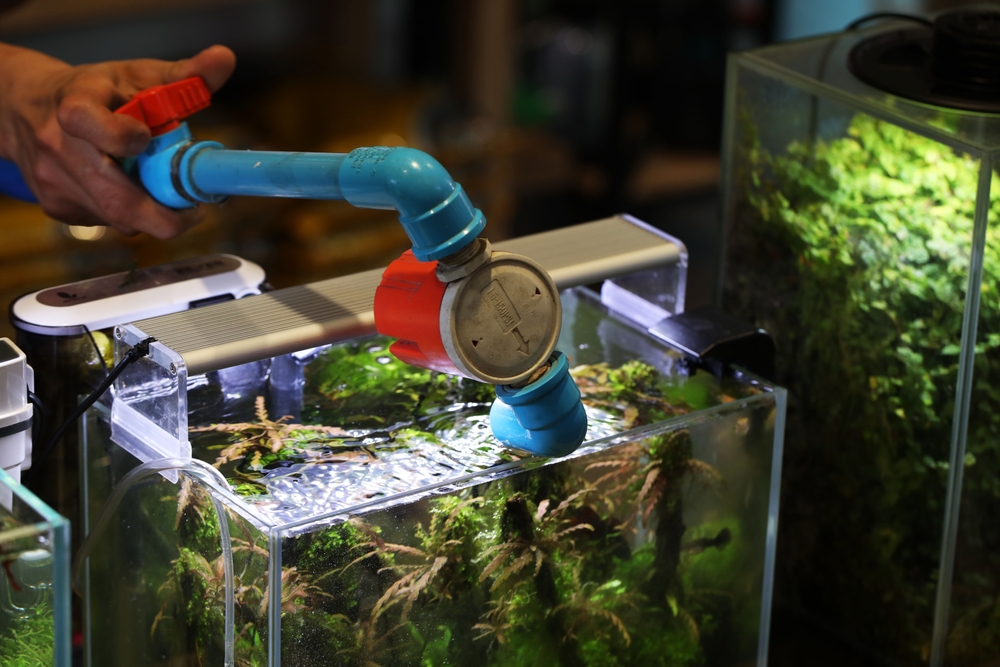
Now that you know something about bettas and where they live in nature, let’s talk about using that knowledge to create a comfortable and robust aquarium environment for your betta. We’ll discuss setting up the aquarium, feeding the occupant, and keeping it healthy.
Tank Conditions
What size of aquarium should you buy? What kind of water should you use? What equipment do you need to maintain the optimum water conditions inside the aquarium? These are the primary relevant tank considerations. Let’s take them in turn.
The tank size is important because it determines how much space your betta has to swim about. A tank at least 5 gallons in size will do. It’s just enough to allow the betta to swim around while leaving enough space for decorations and other equipment, such as heaters and filtration systems.
The heaters will help maintain a stable water temperature. As tropical fish, bettas prefer a temperature range between 75 and 80 degrees Fahrenheit (24 and 27 degrees Celsius). The tank filtration system, in turn, will help clean the water, removing food particles that would otherwise pollute the water and lead to algae growth.
This role is also significant in maintaining other water parameters like ammonia and nitrate levels and pH. However, you’ll still have to change the water periodically.
- Minimum tank size: 5 gallons
- Water temperature: 75-80°F (24-27°C)
- pH: ~7
- Ammonia: 0 ppm
- Nitrite: 0 ppm
Diet and Feeding
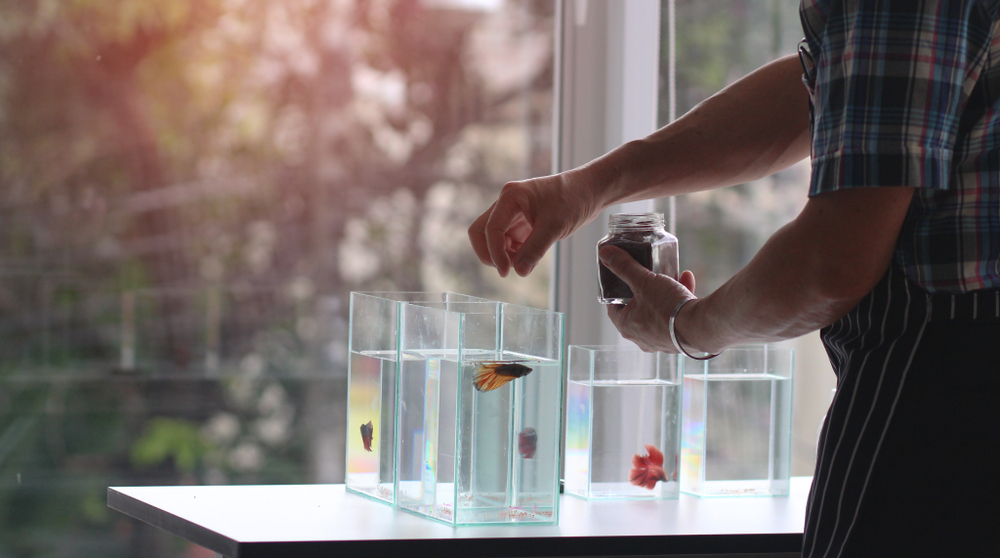
Bettas are carnivorous and thus require high-protein diets. In the wild, they eat zooplankton, insects, insect larvae, and small crustaceans. In captivity, they can live on specially-made betta pellets, flakes, and freeze-dried foods like brine shrimp, daphnia, and blood worms.
Betta fish can feed on plants for a while, especially if push comes to shove, but plant eating is not ideal. Besides, bettas can’t process carbohydrate plants like corn and wheat.
The species has a limited food capacity, and individuals often suffer from overfeeding. As such, feeding them the right amount of food on a proper schedule is necessary.
- Adult Betta: Once or twice a day
- Portions: Size of their eye; avoid overfeeding
Very importantly, betta fish are natural hunters, and they find the meals they have to hunt more enjoyable. So, you should frequently enrich your betta’s feeding experience by giving it live blood worms, insects, insects, or brine shrimp.
Health, Disease Prevention, and Curative Measures
Wild bettas are very prone to illness, which can be hard to recover since they don’t get treatment. You don’t want that for your aquarium betta, so you must provide preventative care and treatment against diseases.
You can preventively care for your betta by maintaining a clean tank, proper diet, and stable water conditions to bolster its immune system. However, your fish may still get sick, so you should watch for signs of illness, such as lethargy, loss of appetite, or color changes, and take immediate action if necessary.
Prevention checklist:
- Regular tank maintenance
- Consistent water quality monitoring
- Quarantine new plants or fish before introduction.
Behavioral Traits and Social Interaction

Bettas’ social behaviors result from their adaptation to their environments and influence their social hierarchies. Aggression is the most common of such behaviors among the species, generally manifesting in territorial behavior and mating activities.
Territorial and Aggressive Behaviors
All bettas are territorial, but the males are more so than the females. A male betta will defend its territory vigorously, flaring up to intimidate any intruder and attacking if they don’t retreat. These flare-up displays involve the betta puffing out its gills and spreading its fins to appear more prominent.
A betta will apply this back-off-or-else policy to all intruders on its territory, whether they are fellow bettas or another species. Consequently, betta fish thrive best when housed alone or with other species that won’t pose a territorial challenge. This is true for male and female bettas, although females prefer sharing space.
If you’ve wondered why male betta community tanks are virtually nonexistent but female betta “sororities” are a bit more familiar, now you know why.
Mating and Reproduction
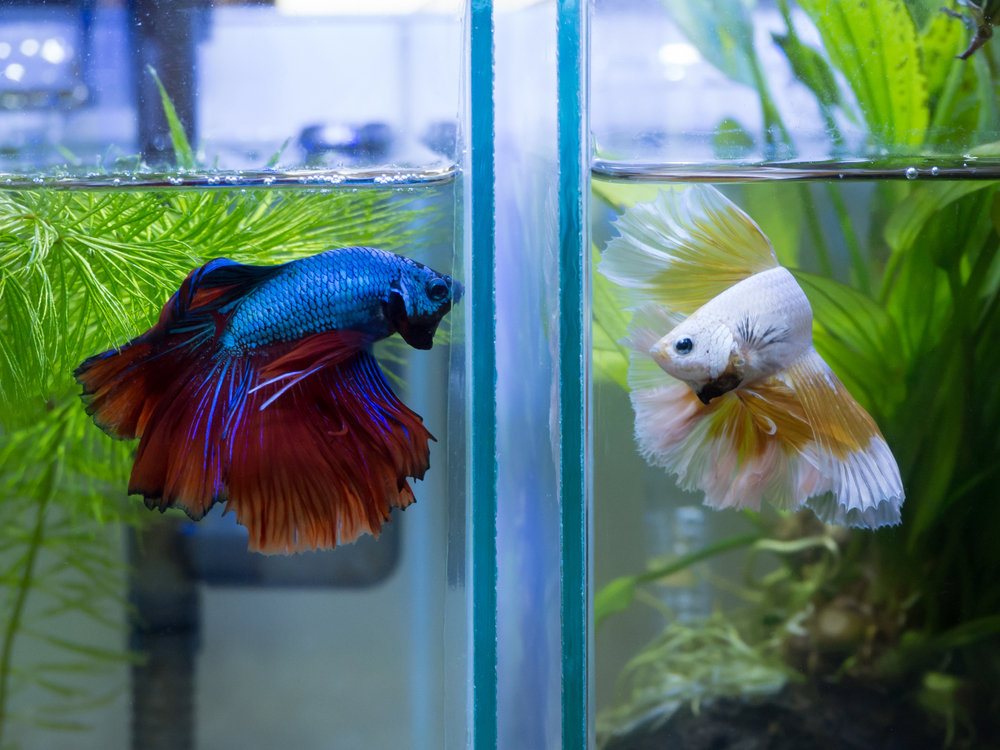
Regarding breeding, male bettas exhibit less aggressive and more constructive behavior. They engage in a fascinating mating ritual that involves the male tirelessly working to create a floating cluster of bubbles at the water’s surface. This cluster is called a bubble nest, a secure place for the female’s eggs.
After a dramatic and often aggressive courtship, the female releases her eggs, and the male fertilizes them. Once the eggs are gathered in the bubble nest, the male betta becomes highly protective of them, ensuring their safety until they hatch.
The social dynamic during this phase is very particular—males are solely responsible for the offspring, and you need to remove the females to prevent the males from viewing them as a threat to the nest.
Final Thoughts on Is a Betta a Tropical Fish?
Other types of fish exist that can grace your aquarium. However, tropical ones like the Siamese fighting fish are the most excellent aquarium fish, hence their overwhelming popularity among aquarists. But while the vibrant colors and curious behaviors of bettas make keeping them very rewarding, those traits require quite some work to stay intact.
If you fail to care for your betta correctly, they may fall sick or become distressed. Both of these states result in dull color and behavior and potentially death. So, now that you know just what type of fish your betta is and what it needs. As a result, you can go in this knowledge and take the best care of your little friend.
Frequently Asked Questions
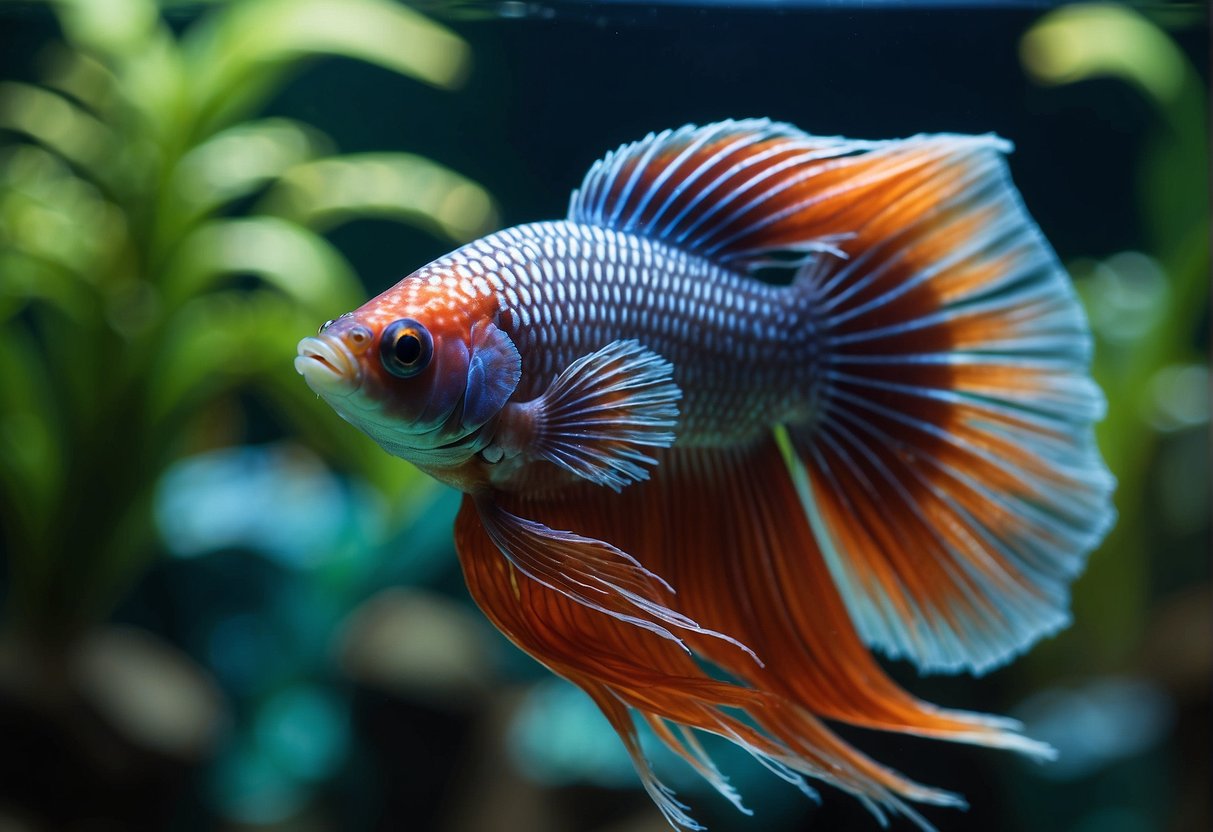
In this section, I’ll address some of the most common inquiries about betta fish, providing clear and concise answers based on reliable information and best practices for betta care.
What type of habitat is suitable for betta fish?
Betta fish thrive in warm, stagnant waters such as rice paddies, which you can replicate in home aquariums. The fish require space and adequate cover for hiding and resting, so you must provide a sizable tank with incredible decorations like plants and smooth rocks.
How long is the lifespan of betta fish in a properly maintained aquarium?
In a well-cared-for environment, betta fish can live 2 to 5 years. Factors such as tank conditions, diet, and genetics influence their lifespan.
Can betta fish coexist with other species in the same tank?
Bettas are territorial, particularly males. They can live with certain peaceful species in a sufficiently large aquarium, but you should be cautious to prevent stress and aggression.
What are the optimal water conditions for maintaining a healthy betta fish?
Bettas require filtered water with a stable temperature of 76 to 81 degrees Fahrenheit. Regular water changes and monitoring for appropriate pH levels are also essential.
How does the care of betta fish in captivity compare to their wild counterparts?
Captive betta aquariums should ideally mimic the species’ natural habitat, providing ample horizontal roaming space and a protein-rich diet. Captivity, however, often limits their environmental diversity, which may influence behaviors such as flare displays.
What factors determine the price range of betta fish in the pet market?
The price of betta fish can vary widely based on several factors, including coloration, fin type, and rarity. Specialty breeds and show-quality bettas often fetch a higher price than standard varieties.

Ian Sterling, founder of Fishlab.com, began his aquarium journey over 30 years ago, driven by a deep fascination for fish and their diverse personalities. His website, Fishlab.com, is dedicated to making fishkeeping accessible and enjoyable, offering beginner-friendly guidance, expert insights, and a community for aquarists to connect and share experiences.


